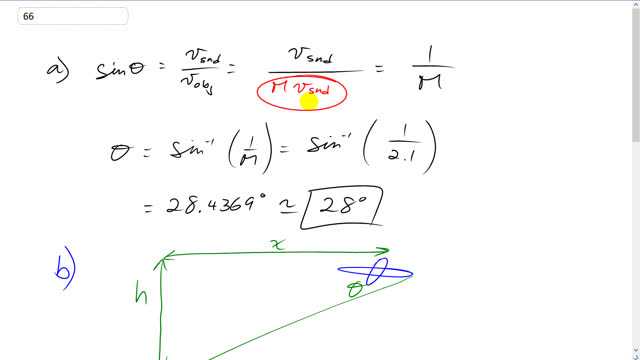
An airplane travels at Mach 2.1 where the speed of sound is 310 m/s.
- What is the angle the shock wave makes with the direction of the airplane’s motion?
- If the plane is flying at a height of 6500 m, how long after it is directly overhead will a person on the ground hear the shock wave?

In order to watch this solution you need to have a subscription.
This is Giancoli Answers with Mr. Dychko. Well, find the angle of the shock wave by taking the sine of that angle equals the speed of sound divided by the speed of the airplane. The speed of the airplane will be the Mach number times the speed of sound. And speed of sound cancels in top/bottom we're left with sine θ is 1 over the Mach number. So, θ will be the inverse sine of 1 over the Mach number. So, it's inverse sine of 1 over 2.1 which is 28 degrees. So, that's the angle here between the shock wave and the velocity. And we can figure out how much time it'll take between when the plane is directly overhead. So, we'll assume that some person is standing here say. And the plane was directly overhead, and then you hear nothing, and then the plane passes some distance, x, and then finally the shock wave which is what you're gonna perceive as a sonic boom, finally reaches a person here after the plane has gone this distance, x. And since the plane is traveling at some speed, v, we know that this distance x is v multiplied by however much time it takes to go from here to here, and t is what we need to figure out. So, t is going to be the distance x traveled horizontally here over the speed of the plane, v. And now, separate line of thought is, knowing that this tangent of this angle θ is the opposite over the adjacent, so the height of the plane is flying at divided by this horizontal distance, x. We can solve for x and, you know, multiply both sides by x over tan θ and you get an x on the left and you get h over tan θ on the right, and we can substitute that in for x in our time formula. So, time is h over tan θ over v. And we can put this tan θ on the bottom here, as I did here, and then replace v with M times v sound, so, that's Mach number times the speed of sound. And we have 6,500 meters height that is flying at divided by 2.1 times 310 meters per second times tan of 28.4369 degrees. And this is about 18 seconds. So, the time between when the plane is directly overhead to when it reaches this location, at which point the sonic boom reaches the person down below, is going to be 18 seconds.